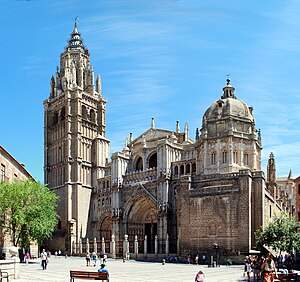
Back كاتدرائية طليطلة Arabic كاتدرائية توليدو ARZ Catedral de Toledo AST Toledo kafedralı Azerbaijani Таледскі сабор Byelorussian Catedral de Toledo Catalan Katedrála Nanebevzetí Panny Marie (Toledo) Czech Kathedrale von Toledo German Καθεδρικός του Τολέδο Greek Katedralo de Toledo Esperanto
This article needs additional citations for verification. (July 2023) |
| Toledo Cathedral | |
|---|---|
| Mary of Toledo | |
| Toledo Cathedral | |
Spanish: Catedral Primada Santa María de Toledo | |
 | |
| 39°51′25.5″N 4°01′26″W / 39.857083°N 4.02389°W | |
| Location | Toledo |
| Country | Spain |
| Denomination | Roman Catholic Church |
| Website | www |
| History | |
| Status | Cathedral |
| Consecrated | 587 |
| Architecture | |
| Functional status | Active |
| Architect(s) | Master Martín Petrus Petri |
| Architectural type | church |
| Style | High Gothic |
| Groundbreaking | 1227[1] |
| Completed | 1493 |
| Specifications | |
| Length | 120 metres (390 ft) |
| Width | 59 metres (194 ft) |
| Nave width | 18 metres (59 ft) |
| Height | 44.5 metres (146 ft) |
| Administration | |
| Archdiocese | Toledo |
| Clergy | |
| Archbishop | Francisco Cerro Chaves |
| Dean | D. Juan Sánchez Rodríguez (Dean of the Chapter[2]) |
| Laity | |
| Organist(s) | Félix González-Mohíno Bartolomé |
The Primatial Cathedral of Saint Mary of Toledo (Spanish: Catedral Primada Santa María de Toledo), otherwise known as Toledo Cathedral, is a Roman Catholic church in Toledo, Spain. It is the seat of the Metropolitan Archdiocese of Toledo.
The cathedral of Toledo is one of the three 13th-century High Gothic cathedrals in Spain and is considered, in the opinion of some authorities, to be the magnum opus[1][3] of the Gothic style in Spain. It was begun in 1226 under the rule of Ferdinand III, and the last Gothic contributions were made in the 15th century when, in 1493, the vaults of the central nave were finished during the time of the Catholic Monarchs. It was modeled after the Bourges Cathedral, although its five naves plan is a consequence of the constructors' intention to cover all of the sacred space of the former city mosque with the cathedral, and of the former sahn with the cloister. It also combines some characteristics of the Mudéjar style, mainly in the cloister, with the presence of multifoiled arches in the triforium. The spectacular incorporation of light and the structural achievements of the ambulatory vaults are some of its more remarkable aspects. It is built with white limestone from the quarries of Olihuelas, near Toledo.
It is popularly known as Dives Toletana (meaning The Rich Toledan in Latin).[4] The Mozarabic Chapel in the Cathedral of Toledo still uses the Hispano-Mozarabic Rite and music.[5][6]
- ^ a b "The History of the Toledo Cathedral". USA Today.
- ^ "Miembros del Cabildo (The Primate's Chapter)" (in Spanish). catedralprimada.es.
- ^ Rosario Díez del Corral Garnica (1987). Arquitectura y mecenazgo: la imagen de Toledo en el Renacimiento. Alianza. ISBN 978-84-206-7066-9.
- ^ In the 15th century this appellation was popularized through a Latin proverb exalting the four Spanish cathedrals considered the grandest, which says: Sancta Ovetensis, pulchra Leonina, dives Toledana, fortis Salmantina.
- ^ Beale-Rivaya, Yasmine (2018). A Companion to Medieval Toledo: Reconsidering the Canons. Brill Publishers. p. 100. ISBN 9789004380516.
- ^ F. Bosch, Lynette M. (2010). Art, Liturgy, and Legend in Renaissance Toledo: The Mendoza and the Iglesia Primada. Pennsylvania State University Press. p. 61. ISBN 9780271043814.
© MMXXIII Rich X Search. We shall prevail. All rights reserved. Rich X Search
